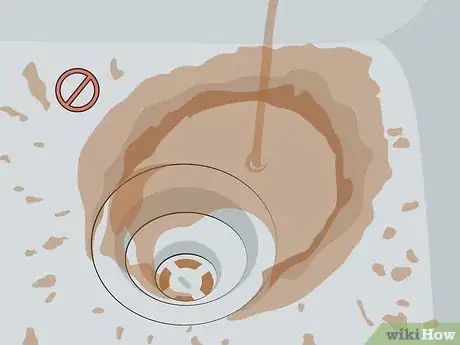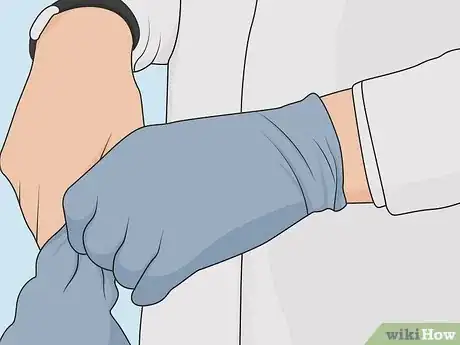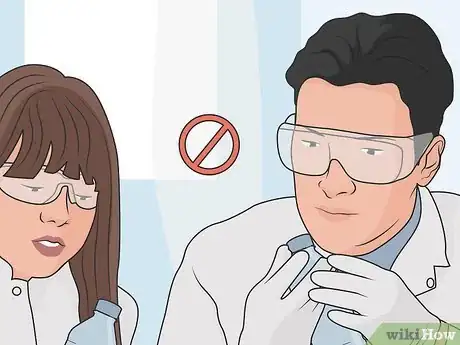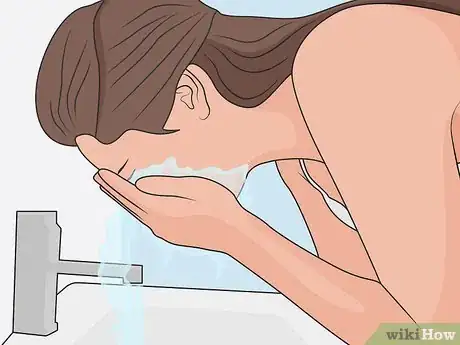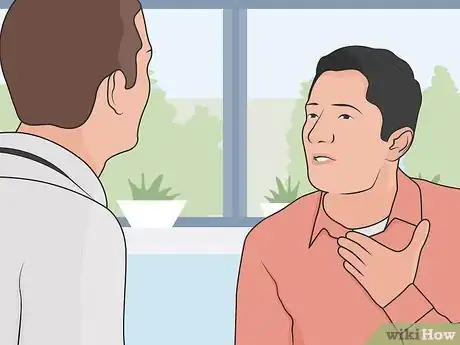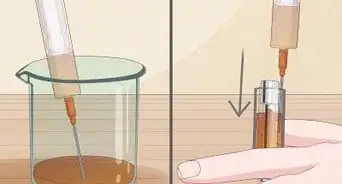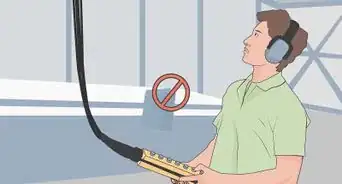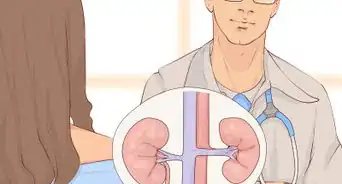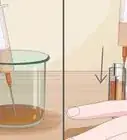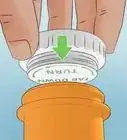This article was co-authored by wikiHow staff writer, Jessica Gibson. Jessica Gibson is a Writer and Editor who's been with wikiHow since 2014. After completing a year of art studies at the Emily Carr University in Vancouver, she graduated from Columbia College with a BA in History. Jessica also completed an MA in History from The University of Oregon in 2013.
This article has been viewed 10,270 times.
Learn more...
Safe disposal of chemicals is critical when you're running experiments in the lab or at home. Iodine monochloride (ICI) is a dark, red-black chemical compound, also known as WIJS solution. It reacts with water to make hazardous fumes and it's corrosive so you'll need to take extra safety precautions when you handle iodine monochloride. To get rid of an ICI solution, pour it in your lab's waste container or contact your local waste management facility.
Steps
Getting Rid of Iodine Monochloride Solutions
-
1Find a hazardous waste facility in your area. Do a web search or call your city government to learn about hazardous waste disposal options. If you're disposing of a small amount of iodine monochloride (ICI) from your home lab, contact your waste management company to ask about their hazardous waste policies.[1]
- If you're disposing of iodine monochloride in a lab setting, follow your lab's waste protocols.
-
2Pour the iodine monochloride into an airtight plastic container. If you're disposing of ICI in a lab, look for the hazardous liquids container in the designated waste area and pour it into the container. To dispose of ICI at home, work in a well-ventilated space and pour your solution into a plastic airtight container that you only use for chemical disposal. Then, seal the container shut.
- Label the outside of the container so no one accidentally opens it.
Advertisement -
3Store the container in a cool, dry space. Keep your iodine monochloride container away from heat and moisture until you can take it to a waste management facility or throw it in the trash for the garbage truck to pick up.
- Iodine monochloride is corrosive, so don't put it into a metal container.
- Most lab waste areas are ventilated and the containers are separated to prevent dangerous reactions.
-
4Take the container to a waste facility. Call your waste management company and ask their policy about hazardous waste. If you've stored it properly, they might tell you to toss it into you household trash for the garbage truck to pick up or they may ask you to bring it to their designated hazardous waste facility.[2]
- In many cases, you'll have to make an appointment to drop off the iodine monochloride. Ask about disposal fees when you make your appointment since some companies might charge to handle hazardous waste.
- If you drive the container to a site, place it into a box so the container doesn't tip over as you drive.
-
5Don't pour iodine monochloride solutions down the drain. When iodine monochloride reacts with water it releases toxic gas. It can also damage wildlife once the solution is released into the sewer system, so never pour the chemical compound down the drain.
- The acetic acid in the iodine monochloride is particularly harmful to fish.
Working Safely Around Iodine Monochloride
-
1Wear long-sleeved clothing or a lab coat to protect your skin. Prevent iodine monochloride from coming into contact with your skin by wearing long pants, long shirts, and covered-toe shoes. If you're in a lab, wear your lab coat and button it to the top for the most coverage.[3]
- If you have long hair, tie it back so it doesn't fall into chemical solutions or get caught on equipment.
-
2Put on safety goggles or a face shield to protect your eyes. For the most protection, choose a face shield or goggles that have side shields. Either of these will prevent iodine monochloride from splashing into your eyes.
- If you wear glasses and contacts, choose glasses when you work with iodine monochloride. If you wear contacts and get ICI into your eyes, it's harder to flush the chemical out of your eyes.
-
3Choose chemical-resistant gloves to keep your hands safe from ICI. Chemical-resistant gloves are thicker to protect against chemical corrosion. Put these on before you work with or dispose of the iodine monochloride.[4]
- Use gloves that you're comfortable working with. If they're too thick and you have trouble gripping things, you may have a hard time safely handling the solution.
-
4Don't eat or drink around iodine monochloride. Keep food and drink out of your lab or workspace so you don't accidentally ingest iodine monochloride. Because ICI is flammable, don't smoke around it either.
- Remember to wash your hands thoroughly after handling iodine monochloride, especially before eating.
Handling Spills and Giving First Aid
-
1Soak up any spilled solution and put it into the waste storage container. If there's been an accident in the lab and iodine monochloride is on the floor or work table, place absorbent material on the liquid. The lab should have inert absorbent material like vermiculite, clay, sand, or pads. Then, put the material into the lab's hazardous waste container.[5]
- Remember to put on personal protective equipment (PPE) before cleaning the spill.
-
2Flush your eyes with water and get medical attention if you get ICI in them. If some of the solution splashes into your eyes or the vapors irritate them, immediately rinse your eyes with lots of water for at least 15 minutes. Lift your upper and lower eyelids as you rinse to completely flush your eyes. Then, get medical attention right away.[6]
- Iodine monochloride can make your corneas turn cloudy, which makes it difficult to see. Ask someone to take you to the hospital for medical attention.
- If you're wearing contacts, discard them before you rinse your eyes.
-
3Rinse exposed skin with water before you get medical care. Take off clothes that have iodine monochloride solution on them. Then, get into the shower or rinse your skin with water from the sink. Flush your skin with water for 15 minutes and get medical attention to treat burns or blisters.
- Put the contaminated clothes into a storage container and wash them thoroughly before you wear them again.
-
4Drink liquids and get emergency medical attention if you ingest ICI. Don't try to vomit up the solution. Instead, drink 2 to 4 cups (470 to 950 ml) of water or milk and get to the hospital immediately.[7]
- It's really important to get emergency medical care since ingesting iodine monochloride can cause gastrointestinal tract burns, spasms, and circulatory problems.
-
5Get fresh air and medical care if you breathe in iodine monochloride. Move away from the spilled or leaking iodine monochloride solution so you don't continue to inhale it. An iodine monochloride solution can cause an allergic respiratory reaction that makes it hard to breathe. Ask someone to get emergency medical care for you.
- If you're caring for someone who's inhaled iodine monochloride, don't give them mouth-to-mouth resuscitation. Trained medics may use a mechanical breathing device to help the person breathe.
Warnings
- Remember, iodine monochloride is a hazardous substance, so wear personal protective equipment and work near ventilation or a lab hood.[8]⧼thumbs_response⧽
- Contact your doctor if you've been exposed to iodine monochloride.⧼thumbs_response⧽
References
- ↑ https://www.epa.gov/hwpermitting/how-do-i-find-hazardous-waste-management-facilities-my-area
- ↑ https://www.epa.gov/hwpermitting/how-do-i-find-hazardous-waste-management-facilities-my-area
- ↑ https://fscimage.fishersci.com/msds/46929.htm
- ↑ https://www.safetyandhealthmagazine.com/articles/9425-selecting-the-appropriate-chemical-resistant-glove
- ↑ https://fscimage.fishersci.com/msds/46929.htm
- ↑ http://www.labchem.com/tools/msds/msds/75349.pdf
- ↑ http://www.labchem.com/tools/msds/msds/75349.pdf
- ↑ https://fscimage.fishersci.com/msds/46929.htm




